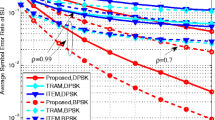Abstract
A novel algorithm is proposed for joint minimum mean-squared error based optimal secondary user transceiver design and user/antenna selection for multiple input multiple-output orthogonal frequency division multiplexing cognitive radio networks. Closed form expressions are developed for the optimal transceiver considering the availability of both full as well as partial channel state information (CSI) of the primary user at the secondary users. Further, optimal transceiver design is also considered for a realistic scenario with CSI uncertainty. In this regard, a low complexity algorithm is presented for joint secondary user and antenna selection towards sum-MSE minimization in cognitive radio networks. Simulation results demonstrate the improved performance of the proposed transceiver design and user/antenna selection algorithm in terms of the MSE performance at the receiver.






Similar content being viewed by others
References
Akyildiz, I. F., Lee, W.-Y., Vuran, M. C., & Mohanty, S. (2006). NeXt generation/dynamic spectrum access/cognitive radio wireless networks: A survey. Computer Networks, 50(13), 2127–2159.
Budiarjo, I., Lakshmanan, M. K., & Nikookar, H. (2008). Cognitive radio dynamic access techniques. Wireless Personal Communications, 45(3), 293–324.
Sridhara, K., Chandra, A., & Tripathi, P. S. (2008). Spectrum challenges and solutions by cognitive radio: An overview. Wireless Personal Communications, 45(3), 281–291.
Tan, L., Zhu, Z., Ge, F., & Xiong, N. (2015). Utility maximization resource allocation in wireless networks: Methods and algorithms. IEEE Transactions on Systems, Man, and Cybernetics: Systems, 45(7), 1018–1034.
Tan, L., & Zhang, Y. (2015). Optimal resource allocation with principle of equality and diminishing marginal utility in wireless networks. Wireless Personal Communications, 84(1), 671–693.
Bansal, G., Hossain, J., & Bhargava, V. K. (2008). Optimal and suboptimal power allocation schemes for OFDM-based cognitive radio systems. IEEE Transactions on Wireless Communications, 7(11), 4710–4718.
Gong, X., Jordan, M., Ishaque, A., Dartmann, G., & Ascheid, G. (2010). Robust MSE-based transceiver optimization in MISO downlink cognitive radio network. In Proceedings (pp. 1–6). IEEE.
Bogale, T. E., & Vandendorpe, L. (2011). MSE uplink-downlink duality of MIMO systems with arbitrary noise covariance matrices. In 2011 45th annual conference on information sciences and systems (CISS). (pp. 1–6). IEEE.
Zhang, L., Liang, Y.-C., Xin, Y., & Poor, H. V. (2009). Robust cognitive beamforming with partial channel state information. IEEE Transactions on Wireless Communications, 8(8), 4143–4153.
Gong, X., Ishaque, A., Dartmann, G., & Ascheid, G. (2010). MSE-based linear transceiver optimization in MIMO cognitive radio networks with imperfect channel knowledge. In IEEE on proceedings. (pp.105–110). IEEE.
Prasad, R. (2008). Special issue on cognitive radio technologies. Wireless Personal Communications, 45(3), 277–279.
Zheng, G., Wong, K.-K., & Ng, T.-S. (2008). Throughput maximization in linear multiuser MIMO–OFDM downlink systems. IEEE Transactions on Vehicular Technology, 57(3), 1993–1998.
Kay, S. M. (1998). Fundamentals of statistical signal processing, Vol. I: Estimation theory. Signal Processing (Vol. I). Upper Saddle River, NJ: Prentice Hall.
Sigdel, S., & Krzymien, W. A. (2009). Simplified fair scheduling and antenna selection algorithms for multiuser MIMO orthogonal space-division multiplexing downlink. IEEE Transactions on Vehicular Technology, 58(3), 1329–1344.
Olkin, I., & Marshall, A. W. (2014). Inequalities: theory of majorization and its applications (Vol. 143). Cambridge: Academic press.
Boyd, S. P., & Vandenberghe, L. (2004). Convex optimization. Cambridge: Cambridge university press.
Sigdel, S., & Krzymień, W. A. (2014). Low complexity user scheduling, ordering and transmit covariance matrix optimization algorithms for successive zero-forcing precoding. Wireless Personal Communications, 75(4), 2467–2484.
Golub, G. H., Van Loan, C. F., & Baltimore. (2012). Matrix computations (Vol. 3). Baltimore: JHU Press.
Ma, C., Kamp, Y., & Willems, L. F. (1994). A frobenius norm approach to glottal closure detection from the speech signal. IEEE Transactions on Speech and Audio Processing, 2(2), 258–265.
Shen, Z., Chen, R., Andrews, J. G., Heath, R. W., & Evans, B. L. (2006). Low complexity user selection algorithms for multiuser MIMO systems with block diagonalization. IEEE Transactions on Signal Processing, 54(9), 3658–3663.
Yeh, W. C., Tsai, S. H., & Lin, P. H. (2012). Reduced complexity multimode antenna selection with bit allocation for zero-forcing receiver. In 2012 IEEE international conference on acoustics, speech and signal processing (ICASSP) (pp. 2937–2940). IEEE, March 2012.
Andrews, J. G., Ghosh, A., & Muhamed, R. (2007). Fundamentals of WIMAX.
Zhang, L., Liang, Y.-C., & Xin, Y. (2008). Robust designs for MISO-based cognitive radio networks with primary user’s partial channel state information. In Global telecommunications conference, (2008). IEEE GLOBECOM 2008. IEEE (Vol. 2008, pp. 1–5). IEEE.
Author information
Authors and Affiliations
Corresponding author
Rights and permissions
About this article
Cite this article
Agrahari, A., Garg, P. & Jagannatham, A.K. Joint Secondary User Transceiver Optimization and User/Antenna Selection for MIMO–OFDM Cognitive Radio Networks with CSI Uncertainty. Wireless Pers Commun 90, 1743–1762 (2016). https://doi.org/10.1007/s11277-016-3422-6
Published:
Issue Date:
DOI: https://doi.org/10.1007/s11277-016-3422-6




